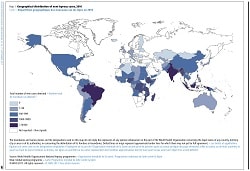World Leprosy Day: Bust the Myths, Learn the Facts

World Leprosy Day is observed on the last Sunday of January each year. Established in 1954 by French philanthropist Raoul Follereau, it aims to raise awareness about leprosy (now called Hansen's disease) and teach people about this ancient disease and that it is easily curable today. While rare in the United States, many people around the world continue to suffer from this curable disease due to lack of access to basic medical care and continued stigma surrounding the illness.
Leprosy was renamed Hansen's disease after Norwegian scientist Gerhard Henrik Armauer Hansen, who in 1873 discovered the slow-growing bacterium now known as Mycobacterium leprae as the cause of the illness. It is difficult to catch, and it can take many years to develop symptoms of the disease following an infection. However, people who catch the disease can be cured with antibiotics.
Together, we can put a stop to discrimination and stigma against people with Hansen's disease. We can learn to recognize symptoms and know when to see a physician for diagnosis. Educate yourself and your community and separate the facts from the myths about Hansen's disease.
Burden of Hansen's Disease
Around the world:
- The number of new cases reported globally to World Health Organization (WHO) in 2015 was more than 200,000.
- Close to 19,000 children were diagnosed with Hansen's disease in 2015, more than 50 a day.
- An estimated 2 to 3 million people are living with Hansen's disease-related disabilities globally.
- In 2015, the countries with the highest number of new diagnoses were India, Brazil, and Indonesia, followed by some of the nations in Africa.
- Two-thirds of all new cases of Hansen's disease are diagnosed in India, which remains home to a third of the world's poor, a group disproportionately affected by the disease.
In the United States:
- About 150 to 250 cases are reported each year.
- In 2015, 178 new cases were reported to the National Hansen's Disease Program (NHDP), which coordinates care, research, and information about Hansen's disease in the U.S.
- Most of those cases occur in people who have lived in areas of the world where the disease is still common.
- Approximately 5,000 people in the U.S. have been cured, but suffer from the long-term complications of Hansen's disease, like paralysis and blindness, and continue to receive care through outpatient clinics and private physicians.
- In some southern states of the U.S., nine-banded armadillos have been found to carry the bacterium that causes Hansen's disease. It is thought that transmission to people may occur when they handle these animals.
Challenges of Hansen's Disease
Hansen's disease mainly affects people in resource-poor countries who live in crowded conditions and have difficulty accessing health care due to long distances to clinics familiar with Hansen's disease, and high cost of going to the doctor. Because of this, despite the WHO's program to provide treatment for free, many of those affected don't complete it or don't receive it at all. In addition, due the continued stigma against people with Hansen's disease, they may not seek help when first symptoms appear, causing delay in diagnosis and development of disabilities.
Girls and women affected by Hansen's disease face the added issue of gender and social discrimination, which may also delay detection of the disease. In some countries, the law allows a person to legally divorce a spouse because they are affected by the disease. Unfortunately, this may leave many women destitute, homeless, and unable to care for their children.
Many people living with Hansen's disease are unable to work due to disability caused by the disease or may face stigma that prevents them from working.
The good news is that Hansen's disease is curable. Education and improving access to basic health services for all are keys to successful elimination of stigma and disability associated with the illness.
Hansen's Disease Myths Busters
There are some common misconceptions about Hansen's disease that continue to cause confusion and fuel stigma and discrimination. Here are eight common myths and facts about the disease.
| Myth | Fact |
|---|---|
Leprosy is very contagious (easy to catch) | Leprosy (Hansen's disease) is hard to catch, and in fact, 95% of adults cannot catch it because their immune system can fight off the bacteria that causes HD. |
Leprosy causes the fingers and toes to fall off | The digits do not "fall off" due to leprosy. The bacteria that causes leprosy attacks the nerves of the fingers and toes and causes them to become numb. Burns and cuts on numb parts may go unnoticed, which may lead to infection and permanent damage, and eventually the body may reabsorb the digit. This happens in advanced stages of untreated disease. |
The leprosy described in historical texts is the same leprosy we know today | Historical leprosy is not the same as modern leprosy. The "leprosy" found in historical and religious texts described a variety of skin conditions from rashes and patchy skin to swelling. They were noted to be very contagious, which is not true for Hansen's disease and also did not have some of the most obvious signs of Hansen's disease, like disfigurement, blindness, and loss of pain sensation. The term was also used for mildew on a person's clothes, possessions or living quarters. |
Leprosy is the result of a sin or curse | Leprosy is caused by the slow-growing bacterium Mycobacterium leprae and is not the result of one's behavior or a curse. |
People who have leprosy need to live in special houses isolated from healthy people | People with leprosy who are being treated with antibiotics can live a normal life among their family and friends and can continue to attend work or school. |
You can get leprosy when sitting next to someone who has the disease | You cannot get leprosy through casual contact such as shaking hands, sitting next to or talking to someone who has the disease. |
Once you catch leprosy, you will die | Leprosy can be cured with antibiotic treatment. |
You are contagious until your treatment is complete | A person is not contagious within a few days of starting the treatment with antibiotics. However, the treatment must be finished as prescribed (which may take up to 2 years) to make sure the infection doesn't come back. |
What You Can Do to Help
Many people think of leprosy as an ancient disease that was eradicated many years ago. But each year, thousands of men, women, and children all over the world develop this disease. Despite effective treatment, leprosy is one of the world's most stigmatized diseases, and people living with leprosy-related disabilities in many countries are shunned, denied basic human rights, and discriminated against. The stigma of leprosy affects the physical, psychological, social, and economic well-being of those with leprosy, contributing to the cycle of poverty in the affected regions.
During World Leprosy Day, we seek to increase public understanding of Hansen's disease and tackle the social stigma attached to this completely curable disease.
How can you do your part?
- Educate yourself about Hansen's disease and share with friends and family that leprosy is a curable illness.
- Educating yourself and others about leprosy helps depict a positive image of leprosy and increase awareness about it in your community.
- Promoting a positive image of leprosy helps focus on the abilities of the affected individuals rather than disability.
- Search for World Leprosy Day activities online and see what's happening in your area.
























.png)











No hay comentarios:
Publicar un comentario